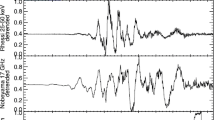Abstract
A time-dependent model for the energy of a flaring solar active region is presented based on an existing stochastic jump-transition model (Wheatland and Glukhov in Astrophys. J. 494, 858, 1998; Wheatland in Astrophys. J. 679, 1621, 2008 and Solar Phys. 255, 211, 2009). The magnetic free energy of an active region is assumed to vary in time due to a prescribed (deterministic) rate of energy input and prescribed (random) jumps downwards in energy due to flares. The existing model reproduces observed flare statistics, in particular flare frequency – size and waiting-time distributions, but modeling presented to date has considered only the time-independent choices of constant energy input and constant flare-transition rates with a power-law distribution in energy. These choices may be appropriate for a solar active region producing a constant mean rate of flares. However, many solar active regions exhibit time variation in their flare productivity, as exemplified by NOAA active region (AR) 11029, observed during October – November 2009 (Wheatland in Astrophys. J. 710, 1324, 2010). Time variation is incorporated into the jump-transition model for two cases: (1) a step change in the rates of flare transitions, and (2) a step change in the rate of energy supply to the system. Analytic arguments are presented describing the qualitative behavior of the system in the two cases. In each case the system adjusts by shifting to a new stationary state over a relaxation time which is estimated analytically. The model exhibits flare-like event statistics. In each case the frequency – energy distribution is a power law for flare energies less than a time-dependent rollover set by the largest energy the system is likely to attain at a given time. The rollover is not observed if the mean free energy of the system is sufficiently large. For Case 1, the model exhibits a double exponential waiting-time distribution, corresponding to flaring at a constant mean rate during two intervals (before and after the step change), if the average energy of the system is large. For Case 2 the waiting-time distribution is a simple exponential, again provided the average energy of the system is large. Monte Carlo simulations of Case 1 are presented which confirm the estimate for the relaxation time and the expected forms of the frequency – energy and waiting-time distributions. The simulation results provide a qualitative model for observed flare statistics in AR 11029.
Similar content being viewed by others
References
Akabane, K.: 1956, Pub. Astron. Soc. Japan 8, 173.
Aschwanden, M.J.: 2005, Physics of the Solar Corona: An Introduction with Problems and Solutions, Springer, Berlin.
Aschwanden, M.J., McTiernan, J.M.: 2010, Astrophys. J. 717, 683.
Barnes, G., Leka, K.D.: 2008, Astrophys. J. Lett. 688, 107.
Benz, A.O.: 2008, Living Rev. Solar Phys. 5, 1.
Biesecker, D.A.: 1994, PhD Thesis, Univ. New Hampshire.
Boffetta, G., Carbone, V., Giuliani, P., Veltri, P., Vulpiani, A.: 1999, Phys. Rev. Lett. 83, 4662.
Charbonneau, P., McIntosh, S.W., Liu, H.-L., Bogdan, T.J.: 2001, Solar Phys. 203, 321.
Chumak, O.V., Zhang, H.-Q., Guo, J.: 2008, Astron. Rep. 52, 852.
Committee on the Societal and Economic Impacts of Severe Space Weather Events: 2008, Severe Space Weather Events: Understanding Societal and Economic Impacts Workshop Report, Space Studies Board ad hoc Committee on the Societal and Economic Impacts of Severe Space Weather Events: A Workshop, The National Academies Press, Washington.
Craig, I.J.D.: 2001, Solar Phys. 202, 109.
Daly, E., Porporato, A.: 2007, Phys. Rev. E 75, 011119.
De Rosa, M.L., Schrijver, C.J., Barnes, G., Leka, K.D., Lites, B.W., Aschwanden, M.J., Amari, T., Canou, A., McTiernan, J.M., Régnier, S., Thalmann, J.K., Valori, G., Wheatland, M.S., Wiegelmann, T., Cheung, M.C.M., Conlon, P.A., Fuhrmann, M., Inhester, B., Tadesse, T.: 2009, Astrophys. J. 696, 1780.
Dun, J., Kurokawa, H., Ishii, T.T., Liu, Y., Zhang, H.: 2007, Astrophys. J. 657, 577.
Gardiner, C.W.: 2004, Handbook of Stochastic Methods, Springer, Berlin.
Hudson, H.S.: 1991, Solar Phys. 133, 357.
Hughes, D., Paczuski, M., Dendy, R.O., Helander, P., McClements, K.G.: 2003, Phys. Rev. Lett. 90, 131101.
Lepreti, F., Carbone, V., Veltri, P.: 2001, Astrophys. J. Lett. 555, 133.
Litvinenko, Y.E.: 1994, Solar Phys. 151, 195.
Lu, E.T.: 1995, Astrophys. J. 447, 416.
Lu, E.T., Hamilton, R.J.: 1991, Astrophys. J. Lett. 380, 89.
Lu, E.T., Hamilton, R.J., McTiernan, J.M., Bromund, K.R.: 1993, Astrophys. J. 412, 841.
Moon, Y.-J., Choe, G.S., Yun, H.S., Park, Y.D.: 2001, J. Geophys. Res. 106, 29951.
Norman, J.P., Charbonneau, P., McIntosh, S.W., Liu, H.-L.: 2001, Astrophys. J. 557, 891.
Odenwald, S., Green, J., Taylor, W.: 2006, Adv. Space Res. 38, 280.
Priest, E.R., Forbes, T.G.: 2002, Astron. Astrophys. Rev. 10, 313.
Rosner, R., Vaiana, G.S.: 1978, Astrophys. J. 222, 1104.
Scargle, J.D.: 1998, Astrophys. J. 504, 405.
van Kampen, N.G.: 1992, Stochastic Processes in Physics and Chemistry. revised and enlarged edn. Elsevier, Amsterdam.
Wheatland, M.S.: 2000, Astrophys. J. Lett. 536, 109.
Wheatland, M.S.: 2001, Solar Phys. 203, 87.
Wheatland, M.S.: 2005, Space Weather 3, 7003.
Wheatland, M.S.: 2008, Astrophys. J. 679, 1621.
Wheatland, M.S.: 2009, Solar Phys. 255, 211.
Wheatland, M.S.: 2010, Astrophys. J. 710, 1324.
Wheatland, M.S., Craig, I.J.D.: 2006, Solar Phys. 238, 73.
Wheatland, M.S., Glukhov, S.: 1998, Astrophys. J. 494, 858.
Wheatland, M.S., Litvinenko, Y.E.: 2001, Astrophys. J. 557, 332.
Wheatland, M.S., Litvinenko, Y.E.: 2002, Solar Phys. 211, 255.
Wheatland, M.S., Sturrock, P.A., McTiernan, J.M.: 1998, Astrophys. J. 509, 448.
Author information
Authors and Affiliations
Corresponding author
Rights and permissions
About this article
Cite this article
Kanazir, M., Wheatland, M.S. Time-Dependent Stochastic Modeling of Solar Active Region Energy. Sol Phys 266, 301–321 (2010). https://doi.org/10.1007/s11207-010-9623-3
Received:
Accepted:
Published:
Issue Date:
DOI: https://doi.org/10.1007/s11207-010-9623-3




